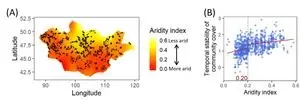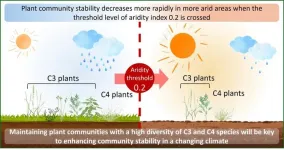(Press-News.org) Humans are outsized actors in the world’s wild places where there are struggles to preserve and protect vital natural resources and animals, birds and plants. Yet people and their plus-sized footprint are rarely discussed in models seeking to predict and plan for trajectories of endangered species.
Sustainability scholars at Michigan State University in this week’s journal Nature Ecology and Evolution reveal the decades-long gaps in research and propose a new way of creating accurate visions for endangered species.
To map and predict species geographic distributions around the globe and understand the factors that drive them, ecologists, conservation biologists and others use powerful computational tools called species distribution models (SDMs). These tools are used for conservation, understanding disease spread, food security, policy planning, and many other applications. To inform their predictions, scientists typically include the surrounding environment, such as climate and natural habitat.
But according to PhD candidate Veronica Frans, “we have a new reality that must be recognized if we want SDM predictions to be realistic and most helpful: we live in a human-dominated world.”
Frans and her advisor Jianguo “Jack” Liu, Rachel Carson chair in sustainability and director of MSU’s Center for Systems Integration and Sustainability, reviewed and synthesized 12,854 published studies covering over 58,000 species around the world, modeled across local to global spatial scales. They found that only 11 percent of those studies included human activities – which Frans said doesn’t reflect reality.
“Nearly half the articles projecting to future climates held human predictors constant over time,” Frans said. “That’s risking false optimism about the effects of human activities compared to climate change.”
They also found how scientists have been considering the future: nearly half of the SDM studies predicting species distributions have used different future climate scenarios but left data related to human activities constant over time. This means that modelers trying to understand where species will be distributed in the next 50 to 100 years were assuming human activities, development, infrastructure, and other human pressures will not change in the future.
“In our current era, human influence is pervasive and human-species interactions are diversifying and amplifying, and yet it is not being well accounted for in one of the most popular modeling tools in ecology,” Frans said.
They noted that modelers haven’t had a choice in the matter: geographic data on future human development have been sparse.
“This is an important aspect we must work to improve, since nature and humans are tightly linked, not only locally, but also across long distances” Liu said. “They form metacoupled human and natural systems. We will only be able to make significant and swift progress toward global sustainability when we consider all aspects of our real world.”
The article “Gaps and opportunities in modeling human influence on species distributions in the Anthropocene,” was funded by the National Science Foundation and Michigan AgBioResearch.
END
Humans are the elephant in the room where conservation is debated
2024-06-12
ELSE PRESS RELEASES FROM THIS DATE:
No bones about it: 100-million-year-old bones reveal new species of pterosaur
2024-06-12
New Curtin University-led research has identified 100-million-year-old fossilised bones discovered in western Queensland as belonging to a newly identified species of pterosaur, which was a formidable flying reptile that lived among the dinosaurs.
Unearthed in 2021 by Kronosaurus Korner museum curator Kevin Petersen, the fossilised remains have been found to belong to Haliskia peterseni, a new genus and species of anhanguerian pterosaur.
Based on the shape of its skull, arrangement of teeth and shape of the shoulder bone, a research team led by ...
City of Hope CAR T cell therapy for advanced prostate cancer demonstrates positive results in phase 1 clinical trial
2024-06-12
City of Hope CAR T cell therapy for advanced prostate cancer demonstrates positive results in phase 1 clinical trial
• Trial results published today in Nature Medicine
• A phase 1b trial using the same CAR T cell therapy has opened
LOS ANGELES — Treating prostate cancer with immunotherapy is currently difficult to do. But results from a first in-human phase 1 trial using a chimeric antigen receptor (CAR) T cell therapy developed by researchers from City of Hope®, ...
Exposure to heat and cold in early life may affect development of white matter in the brain
2024-06-12
Barcelona, 12 June 2024 (EMBARGOED) -. Brain scans of more than 2,000 preadolescents suggests that early life exposure to heat and cold may have lasting effects on the microstructure of white matter in the brain, especially when living in poorer neighbourhoods. The study, published in Nature Climate Change, highlights the vulnerability of foetuses and children to extreme temperatures. This research has been led by the Barcelona Institute for Global Health (ISGlobal), a centre supported by the “la Caixa” Foundation, and IDIBELL, in collaboration with the Erasmus University Medical Center Rotterdam ...
The role of biodiversity in mitigating rapid loss of plant community stability in drylands during changing climate
2024-06-12
An international research team undertook a study of plants in the Mongolian grasslands to evaluate the stability of these plant communities over time. They specifically looked at how the dryness of the climate impacted the plant communities and determined that the stability of the plant communities decreased more rapidly in more arid areas. This research helps in the development of effective management strategies that promote stable ecosystems in a time of changing climate.
The research is published in the journal Global Change Biology on June 12, 2024.
Scientists know that climate change affects the way biodiversity influences the stability of plant ...
Continuous vs intermittent β-lactam antibiotic infusions in critically ill patients with sepsis
2024-06-12
About The Study: The observed difference in 90-day mortality between continuous versus intermittent infusions of β-lactam antibiotics did not meet statistical significance in the primary analysis. However, the confidence interval around the effect estimate includes the possibility of both no important effect and a clinically important benefit in the use of continuous infusions in this group of patients.
Quote from corresponding author Joel M. Dulhunty, M.D., Ph.D.:
“The BLING III trial provides important evidence to guide antibiotic management and improve outcomes for patients with sepsis. This large randomized clinical trial involved over ...
Prolonged vs intermittent infusions of β-lactam antibiotics in adults with sepsis or septic shock
2024-06-12
About The Study: Among adults in the intensive care unit who had sepsis or septic shock, the use of prolonged β-lactam antibiotic infusions was associated with a reduced risk of 90-day mortality compared with intermittent infusions. The current evidence presents a high degree of certainty for clinicians to consider prolonged infusions as a standard of care in the management of sepsis and septic shock.
Corresponding Author: To contact the corresponding author, Jason A. Roberts, B.Pharm., Ph.D., email j.roberts@uq.edu.au.
To ...
Does inflammation in mid-life affect late-life mobility?
2024-06-12
In a recent study published in the Journal of the American Geriatric Society, having high inflammation in mid-life was associated with a clinically meaningful slower gait speed—an indicator of mobility—20 years later.
In the study, which included 4,758 community-dwelling adults, the link between high inflammation and slower late-life gait speed was especially strong for people with sustained high inflammation over the 20-plus years of follow-up. The association was evident even among the healthiest adults who never experienced other common conditions such as obesity, hypertension, ...
Does children’s sensitivity to their parents’ praise affect their future mental health?
2024-06-12
A new study published in Developmental Science found that children who were more positively sensitive to their parents’ praise when they were 3 years old had fewer behavioral and emotional problems when they were 5–7 years old. Children whose behavior did not depend on their mood also had fewer behavioral and emotional problems later.
For the study, which involved 60 children, parents sent in videos of their 3-year-olds brushing their teeth each night across 16 days. Toothbrushing time served as a measure of child behavior. Investigators also noted the amount of ...
How can artificial intelligence be applied to the business needs of the electric power industry?
2024-06-12
A recent study published in IET Generation, Transmission & Distribution explores how artificial intelligence—in particular machine learning techniques—can be leveraged as powerful tools for the electric power and energy industry, and for managing its assets.
By showcasing practical applications and success stories, the study demonstrates the growing acceptance of machine learning as a valuable technology for current and future business needs in the power sector. It also assesses the barriers and difficulties of implementing large-scale ...
Could a novel liver patch help treat and prevent liver disease?
2024-06-12
As described in research published in the Biotechnology Journal, investigators have developed a novel patch that can help liver tissue regenerate.
The patch is a combination of decellularized liver matrix, a liver growth factor, and an anticoagulant. In lab tests with liver cells, the patch helped liver cells regain function after exposure to a toxin.
In rats, patches attached to the liver and gut promoted recovery from liver fibrosis, with notable decreases in scarring and inflammation.
“The decellularized liver matrix–based hepatic patch has demonstrated the ability to ...



